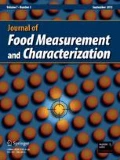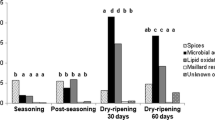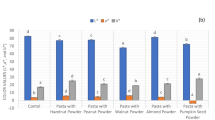Abstract
Loach (Misgurnus anguillicaudatus) from Heilongjiang Province, China, was processed via curing in brine solution and frying in soybean oil to obtain a ready-to-eat fried loach in this study. Some chemical, volatile, and textural indices of the fried loach were assessed to reflect its quality attributes. The fried loach had enhanced protein and lipid contents of 349.4 and 200.6 g/kg, respectively, and increased ash and NaCl contents, as the results of curing as well as frying-induced water loss and oil uptake. The fried loach also had the respective ratios of essential amino and fatty acids to total amino and fatty acids about 39 and 13 %. Protein fraction from the fried loach had amino acid profile similar to that of the fresh loach, indicating the frying had insignificant impact on loach protein. As the result of oil uptake, lipid fraction of the fried loach was different from that of the fresh loach in fatty acid profile, including higher oleic (46.4 vs. 44.8 %) and linoleic acids (12.4 vs. 3.6 %) but lower docosahexenoic (8.7 vs. 10.4 %) and arachidonic acids (0.8 vs. 2.8 %). In comparison with the fresh loach, the fried loach showed increased hardness, springiness, and chewiness by 65, 98, and 385 %, respectively. In addition, twenty-six volatiles of six types and twenty-eight volatiles of eight types were detected in the fresh and fried loaches, respectively; however, the furans and pyrazines arisen from the frying were only detectable in the fried loach.
Similar content being viewed by others
References
FAO, Fisheries and Aquaculture, http://www.fao.org/fishery/aquaculture/zh (2011)
P. Puwastien, K. Judprasong, E. Kettwan, K. Vasanachitt, Y. Nakngamanong, L. Bhattacharjee, Proximate composition of raw and cooked Thai freshwater and marine fish. J. Food Compos. Anal. 12, 9–16 (1999)
L. Lauritzen, H.S. Hansen, M.H. Jørgensen, K.F. Michaelsen, The essentiality of long chain n-3 fatty acids in relation to development and function of the brain and retina. Prog. Lipid Res. 40, 1–94 (2001)
C.L. Broadhurst, Y.Q. Wang, M.A. Crawford, S.C. Cunnane, J.E. Parkington, W.F. Schmidt, Brain-specific lipids from marine, lacustrine, or terrestrial food resources: potential impact on early African Homo sapiens. Comp. Biochem. Phy. 131, 653–673 (2002)
Z. Usydus, J. Szlinder-Richert, M. Adamczyk, Protein quality and amino acid profiles of fish products available in Poland. Food Chem. 112, 139–145 (2009)
B. Tokur, The effect of different cooking methods on proximate composition and lipid quality of rainbow trout (Oncorhynchus mykiss). Int. J. Food Sci. Technol. 42, 874–879 (2007)
A. Romero, C. Cuesta, F.J. Sanchez-Muniz, Cyclic fatty acid monomers and thermoxidative alteration compounds formed during frying of frozen foods in extra virgin olive oil. J. Am. Oil Chem. Soc. 77, 1169–1175 (2000)
S. Bastida, F.J. Sánchez-Muniz, Thermal oxidation of olive oil, sunflower oil and a mix of both oils during forty discontinuous domestic fryings of different foods. Food Sci. Technol. Int. 7, 15–23 (2001)
G.F.Ü. Şengör, D.Ü. Alakavuk, Ş.Y. Tosun, Effect of cooking methods on proximate composition, fatty acid composition, and cholesterol content of Atlantic Salmon (Salmo salar). J. Aquat. Food Prod. Tech. 22, 160–167 (2013)
B. Ersoy, Effects of cooking methods on the proximate, mineral and fatty acid composition of European eel (Anguilla anguilla). Int. J. Food Sci. Technol. 46, 522–527 (2011)
T. Pérez-Palacios, C. Petisca, S. Casal, I.M.P.L.V.O. Ferreira, Changes in chemical composition of frozen coated fish products during deep-frying. Int. J. Food Sci. Nutr. 65, 212–218 (2013)
D. Larsen, S.Y. Quek, L. Eyres, Effect of cooking method on the fatty acid profile of New Zealand King Salmon (Oncorhynchus tshawytscha). Food Chem. 119, 785–790 (2010)
H.X. Wang, L. Qin, Y. Wang, D.Y. Zhou, S. Song, X.S. Wang, B.W. Zhu, Effects of heating conditions on fatty acids and volatile compounds in foot muscle of abalone Haliotis discus hannai Ino. Fisheries Sci. 80, 1097–1107 (2014)
D. Larsen, S.Y. Quek, L. Eyres, Evaluating instrumental colour and texture of thermally treated New Zealand King Salmon (Oncorhynchus tshawytscha) and their relation to sensory properties. LWT-Food Sci. Technol. 44, 1814–1820 (2011)
G.S. Yasui, T. Fujimoto, S. Sakao, E. Yamaha, K. Arai, Production of loach (Misgurnus anguillicaudatus) germ-line chimera using transplantation of primordial germ cells isolated from cryopreserved blastomeres. J. Anim. Sci. 89, 2380–2388 (2011)
K. Morishima, I. Nakayama, K. Arai, Genetic linkage map of the loach Misgurnus anguillicaudatus (Teleostei: Cobitidae). Genetica 132, 227–241 (2008)
C.H. You, X.M. Yu, J.O. Tong, Detection of hybridization between two loach species (Paramisgurnus dabryanus and Misgurnus anguillicaudatus) in wild populations. Environ. Biol. Fish 86, 65–71 (2009)
AOAC, Official Methods of Analysis of Association of Official Analytical Chemists, 17th edn. (Association of Official Analytical Chemists, Arlington, 2000)
S.M. Basha, R.M. Roberts, Simple colorimetric method for the determination of tryptophan. Anal. Biochem. 77, 378–386 (1977)
J. Folch, M. Lees, G.H.S. Stanley, A simple method for the isolation and purification of total lipids from animal tissues. J. Biol. Chem. 226, 497–509 (1957)
M.R. Neff, S.P. Bhavsar, E. Braekevelt, M.T. Arts, Effects of different cooking methods on fatty acid profiles in four freshwater fishes from the Laurentian Great Lakes region. Food Chem. 164, 544–550 (2014)
M.D. Ayala, I. Abdel, M. Santaella, C. Martínez, M.J. Periago, F. Gil, A. Blanco, O.L. Albors, Muscle tissue structural changes and texture development in sea bream, Sparus aurata L., during post-mortem storage. LWT-Food. Sci. Technol. 43, 465–475 (2010)
J. Weber, V.C. Bochi, C.P. Ribeir, A.D.M. Victório, T. Emanuelli, Effect of different cooking methods on the oxidation, proximate and fatty acid composition of silver catfish (Rhamdia quelen) fillets. Food Chem. 106, 140–146 (2008)
B. Ersoy, A. Özeren, The effect of cooking methods on mineral and vitamin contents of African catfish. Food Chem. 115, 419–422 (2009)
FAO/WHO, Protein quality evaluation. Report of Joint FAO/WHO Expert Consultation. FAO Food and Nutrition Paper (Food and Agriculture Organization of the United Nations, Rome, 1991)
J. Gao, S. Koshio, B.T. Nguyen, W.M. Wang, X.J. Cao, Comparative studies on lipid profiles and amino acid composition of wild and cultured Dojo loach Misgurnus anguillicaudatus obtained from southern Japan. Fish. Sci. 78, 1331–1336 (2012)
M.I. Gladyshev, N.N. Sushchik, G.A. Gubanenko, S.M. Demirchieva, G.S. Kalachova, Effect of boiling and frying on the content of essential polyunsaturated fatty acids in muscle tissue of four fish species. Food Chem. 101, 1694–1700 (2007)
D.S. Mottram, Flavour formation in meat and meat products: a review. Food Chem. 62, 415–424 (1998)
R. Domínguez, M. Gómez, S. Fonseca, J.M. Lorenzo, Influence of thermal treatment on formation of volatile compounds, cooking loss and lipid oxidation in foal meat. LWT-Food Sci. Technol. 58, 439–445 (2014)
M.L. Timón, A.I. Carrapiso, Á. Jurado, J. van de Lagemaat, A study of the aroma of fried bacon and fried pork loin. J. Sci. Food Agr. 84, 825–831 (2004)
A. Becalski, D. Forsyth, V. Casey, B.P.Y. Lau, K. Pepper, S. Seaman, Development and validation of a headspace method for determination of furan in food. Food Addit. Contam. 22, 535–540 (2005)
M.R. Ramírez, M. Estévez, D. Morcuende, R. Cava, Effect of the type of frying culinary fat on volatile compounds isolated in fried pork loin chops by using SPME-GC-MS. J. Agr. Food Chem. 52, 7637–7643 (2004)
S. Bhattacharya, G.S. Choudhury, S. Studebaker, Hydrothermal processing of Pacific chum salmon: effects on texture and in vitro digestibility. J. Food Quality 16, 243–251 (1993)
S. Damodaran, Amino acids, peptides, and protein, in Food Chemistry, 3rd edn., ed. by O.R. Fennema (Marcel Dekker Inc, Now York, 1996), pp. 321–429
Acknowledgments
The authors thank the anonymous reviewers and editors for their valuable advices.
Author information
Authors and Affiliations
Corresponding author
Rights and permissions
About this article
Cite this article
Lv, ML., Zhao, XH. Chemical, volatile and textural attributes of a ready-to-eat fried loach (Misgurnus anguillicaudatus). Food Measure 10, 357–363 (2016). https://doi.org/10.1007/s11694-016-9314-3
Received:
Accepted:
Published:
Issue Date:
DOI: https://doi.org/10.1007/s11694-016-9314-3




